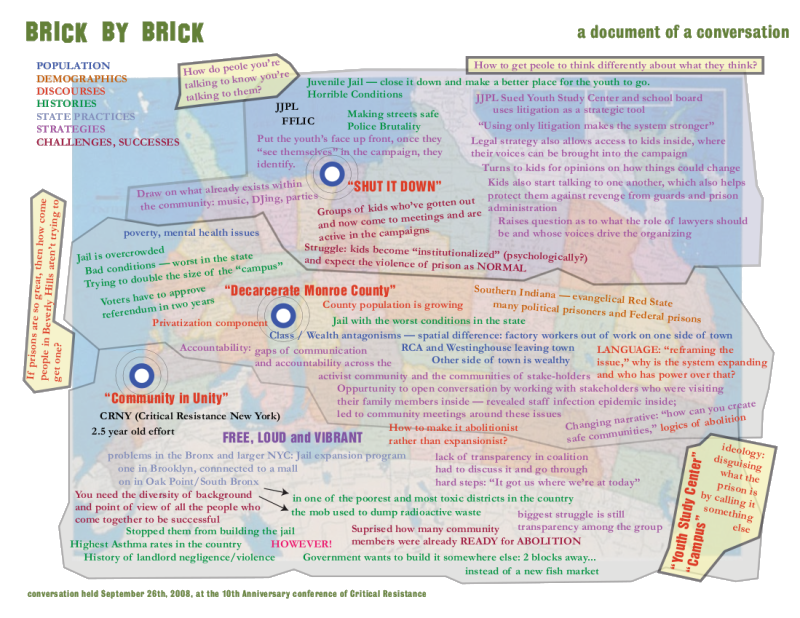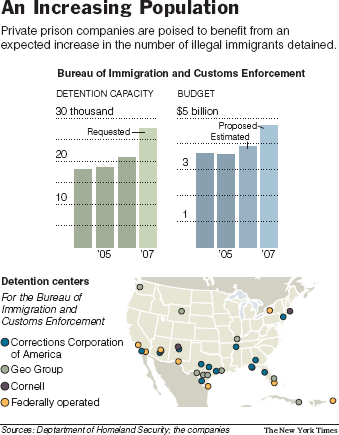This has been sitting in my drafts for way too long. Just going to post it and maybe add to it later. Besides, I wanted to post the conversation map which I think is pretty interesting …
I got back from the CR10 conference in Oakland yesterday and still fill sleep deprived and like my head is exploding, not only with the head cold I picked up, but with thoughts, ideas, critiques, and questions. I’m going to try really hard to give myself a rundown of everything that was on my mind throughout the conference as clearly, and with as much sane organization as I can.
Local Jail Resistance

Brick By Brick (PDF)
The primary reason that I went to CR10 was to be part of the Decarcerate Monroe County posse that was participating along, with two other groups, in a workshop titled “Taking it Down, Brick by Brick: Local Anti-Jail Campaigns”. We shared the workshop with Community in Unity from NYC who successfully defeated a proposal to build a jail in the Bronx and is now struggling against the construction of that jail in a new location, and Juvenile Justice Project of Louisiana, a group that is trying to shut down an infamous juvenile jail in NOLA. The format was a “fishbowl” conversation, with a facilitator asking the groups different questions and representatives from the 3 groups providing answers. One cool addition to the workshop was videographer Ashley Hunt doing a real time visual map of some of the ideas that were brought up during the discussion.
Different communities, same story when it comes to jails
One would never think of the Bronx, New Orleans and Bloomington as having very much in common, but when it comes to the rhetoric of jail expansion, these places have a lot in common. Both proposed sites in the Bronx for the jail (Oak Point and Hunts Point) were in poor areas of the city and both were very environmentally toxic and in close proximity to things like waste management facilities and power plants. Environmentally-related health problems like asthma were more frequent in the community where they wanted to build the jail. One of the proposed sites for Bloomington’s new jail is on the south side of town, near a primarily working-class residential neighborhood. It would also be on the site of a closed industrial manufacturing facility, though I’m not sure if the environmental implications of the industrial site have been studied yet.
A similar parallel can be seen in the euphemisms used for jails. In Bloomington, the proposal was for a “Justice Campus”. In NOLA, the youth jail, where spoiled milk at meals and rat infestations were reported as common, is called the “Youth Study Center.”
Finally, improved conditions and easier access to visitation, both of which are used to rationalize jail and juvenile detention center construction in Bloomington, were also used as rationalizations for jail expansion in the Bronx. Proponents of the jail argued that people housed in the new jail would be closer to their communities, though the change in proximity would be marginal according to CIU folks. Also, jail advocates claimed that it would allow some incarcerated people to be moved from the notoriously bad Riker’s Island facility. What seemed different from Bloomington is the fact that such arguments seemed to have much less traction in NYC than in Bloomington. I don’t know why this is, though I think that many in Bloomington have fewer connections with incarceration so may be more trustful of the possibility of a kinder, gentler jail. For people directly affected by incarceration in Monroe County, their marginilization from political and cultural power in the community and the lack of a history of political organizing with the leadership of poor people or people of color may make people feel like they have to cut their losses and hope that a new jail would provide some improvement in the conditions for their loved ones.
Still, the workshop definitely made me look beyond my mapping of power in the community. I think it’s easy to see forces like the University as privileged, marginalizing, and moreover, homogeneous. The moderator pointed out that, within the University, their may be many people from backgrounds of poverty or first-generation scholars for whom the politics of jail resistance may resonate strongly. I had always been wary of having organizing against jail expansion involve the university too much because of tensions between university students and other community members and because of the different experiences of people affected by the jail and many student activists, but there are probably groups of people at the university who have experiences with incarceration for whom resistance to the jail would resonate.
Strategies
JJPL had strategic considerations that followed from part of their efforts involving a lawsuit about the conditions at the youth facility. While the results of this lawsuit essentially only result from building a better jail rather than movement toward alternatives to jails, the lawsuit facilitated direct access to youth in the facility. JJPL workers were allowed to interview youth as part of the lawsuit which allowed the gathering of information for both investigation and advocacy. When talking to youth in the facility, JJPL noted that it was important to involve a large number of youth to prevent a baclash against youth who spoke out. JJPL warned that while working with lawyers, it was important to have an equal flow of information and leverage in decision making in both the areas of media/organizing and litigation.
JJPL also used a lot of strategies to connect with youth who had been incarcerated or who were from neighborhoods where a lot of youth were incarcerated. These included cookout events with DJs that doubled as planning events for the campaign. One of the people with JJPL ran a record label and used hip hop music as part of his organizing. JJPL also made efforts to keep in touch with youth they had met doing interviews while the youth were incarcerated so that they could be involved in organizing once they were released. One issue with working with incarcerated youth was that some were described as being “institutionalized”, or having difficulty examining the youth facility critically. However, JJPL said that one youth’s comment that he didn’t think the facility should be closed sparked a long and constructive conversation about their organizing. I wish I would have heard the content of that conversation.
CIU involved affected people by working with a therepeutic community called La Casita to organize speak outs about incarceration. They also used a variety of media strategies to try to encourage opposition to the jail. These included making maps that showed the human geography (economic background, race, environmental factors) of the sites for the proposed jail, a list of 50 other ways to spend the money on the jail, and a lot of emphasis on questioning why new jails were only planned to be constructed in poor communities. They also tried to create media events that put decision makers face to face with formerly incarcerated people.
 []
[]


